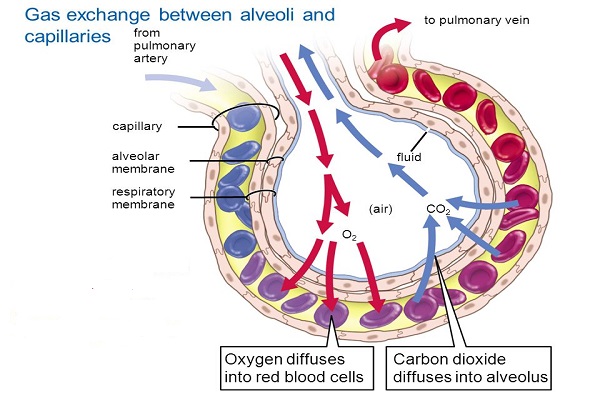Mechanism of Respiration in Human
Mechanism of Respiration in Human
Respiration is simply defined as the exchange of oxygen and carbon dioxide into the body.
Physiology of respiration can be described under following phases:
- External respiration
- Transport of oxygen
- Internal respiration
- Transport of carbon dioxide

-
External respiration
It is the first step of respiration.
It occurs in lungs.
It is the exchange of gases by diffusion between alveoli and blood in blood vessel, across respiratory membrane.
During inspiration, oxygen is taken into the lungs. The partial pressure of oxygen in lungs is higher than that in blood capillaries.
Therefore, oxygen diffuses from the lungs to the blood.
Similarly, the venous blood contain high level of CO2 in comparison to lungs. Due to high partial pressure of CO2 in blood and low CO2 in lungs, the CO2 diffuses from the blood into the lungs in order to maintain the equilibrium.
-
Transport of oxygen
Oxygen is transported from lungs to the tissue in blood.
Plasma and RBC are helpful in transporting the oxygen.
Water present in plasma has poor solubility for oxygen, so it carries only 3% of total oxygen.
Most of the oxygen (about 97% of total oxygen) is transported by RBC.
RBC has a respiratory pigment hemoglobin which combines with oxygen to form oxyhemoglobin due to high affinity of hemoglobin with oxygen.
Almost all oxygen are transported in this form, from lungs to tissue.
Hb4 + 4O2 Hb4O8
Oxyhemoglobin compound is highly unstable compound and thus can dissociate quickly as it reaches to tissue.
NOTE: One hemoglobin molecules contain 4 heme group; each heme can combine with oxygen. Therefore, one Hb can combine with 4 molecules of oxygen. A normal adult person has 15 gram hemoglobin per 100ml of blood. 1 gm of Hb can carry upto 1.34 ml of oxygen. 100 ml of blood conatains about 20ml of oxygen.
-
Internal respiration
This process takes place inside the cells in various tissue, hence called tissue respiration.
It includes two steps:
i. Dissociation of oxyhemoglobin
As the oxyhemoglobin reaches to the tissue, it quickly dissociates into free oxygen and hemoglobin.
Oxygen enters into tissue, whereas the hemoglobin returns back to the RBC to pick up more oxygen.
Hb4O8 Hb4 + 4O2
ii. Oxidation of food/ Tissue respiration
The oxygen oxidizes the glucose in presence of respiratory enzyme and releases energy, water and CO2. Energy is stored in the form of ATP in mitochondria to perform the metabolic activities whereas the CO2 is expelled from the tissue.
C6H12O6 6CO2 +6H2O + Energy
-
Transportation of carbon dioxide
Carbon dioxide is the waste product which is produced in the body as a result of tissue respiration. Since CO2 is very toxic, it is essential to remove out from the body. CO2 is transported from tissue to lungs in following ways:
i. In the form of carbonic acid
CO2 combines with water of RBC to form carbonic acid. The process is catalyzed by an enzyme carbonic anhydrase found in RBC.
About 7% of the total CO2 are transported in this form.
CO2 + H2O carbonic anhydrase H2CO3 (carbonic acid)
ii. In the form of bicarbonates
Carbonic acid quickly ionizes to form ions i.e. bicarbonate and hydrogen ions.
Bicarbonates ions are pumped through RBC membrane into plasma.
Bicarbonates combines either sodium or potassium of plasma to form sodium bicarbonate or potassium bicarbonate respectively.
CO2 is carried from tissue to the lungs through plasma.
About 70% of CO2 are transported in this form.
These bicarbonates are carried through plasma to lungs where they combine with hydrogen ion and form water and carbon dioxide. The CO2 is expelled out during expiration.
iii. In the form of carbamino hemoglobin compound
CO2 combines with amino group of haemoglobin to form a complex caramino hemoglobin compound.
CO2 + HHb-NH2 Hb-NH-COOH
About 20-23% of CO2 are transported in this form.In this way all the CO2 produced in tissue are transported to lungs form where it is expelled out through expiration.

Good
Your notes are very helpful for me….Thanks a lot!!!
Very helpful notes for me…👌👍
Good keep it up your notes are good and easy to understand thanks.
Thanks